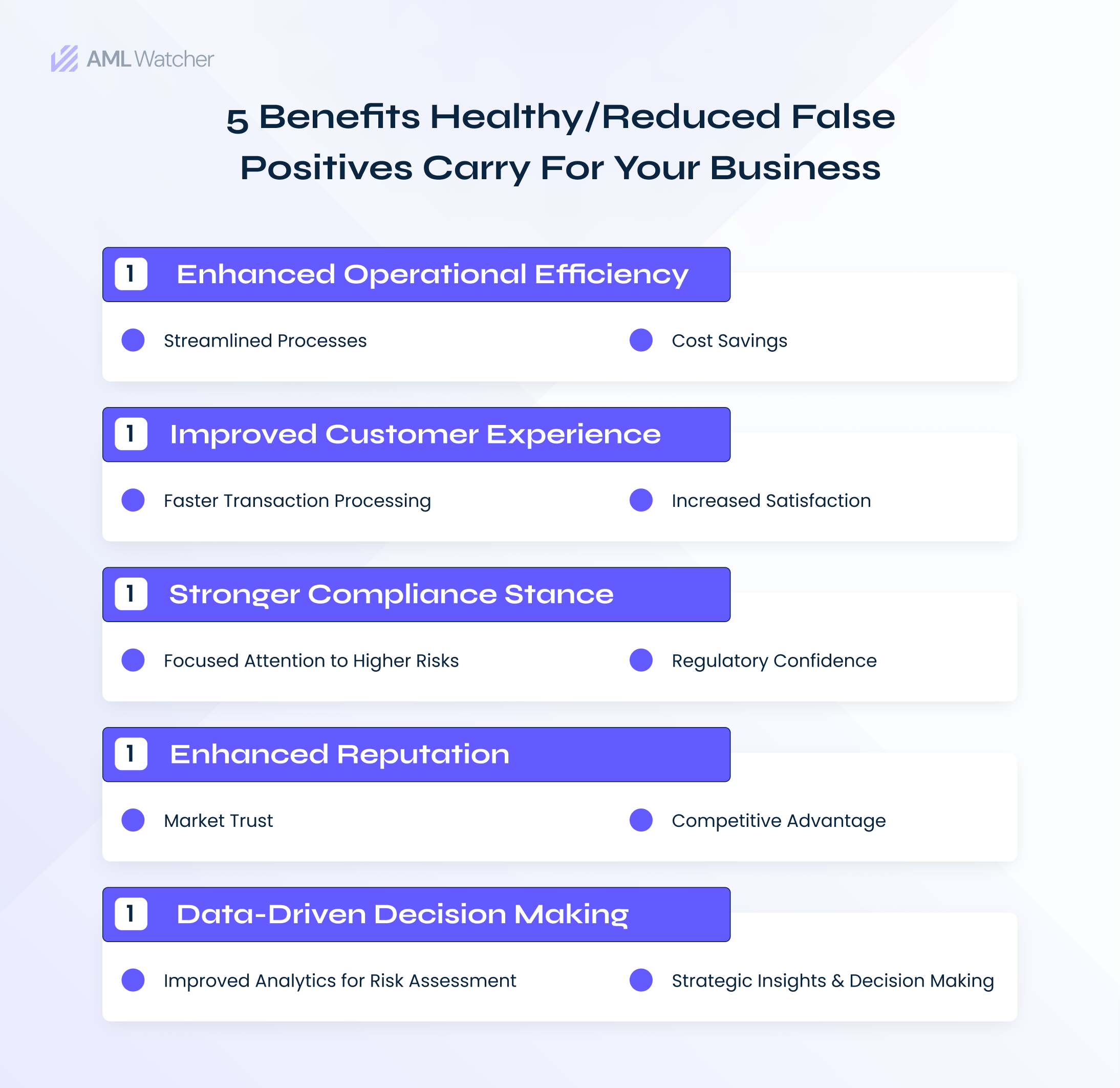
How to Manage Healthy AML False Positive in 2024?
Taxes and death have been nominated as the most uncertain things by an economist, Franklin Benjamin. If we expand the horizon to compliance and the fight against money laundering and financing for terrorism, AML’s false positives add up to the existing uncertainties.
What is a false positive? Precisely, an operational error that generates a false alarm by identifying increased AML risk when actually it is not. Increasing the compliance burden for institutions, false positives cause financial exhaustion in terms of resource utilization and time allocation in manual verification of generated alarms.
In an effort to protect global financial stability and prevent criminals from violating global regulatory protocols, around $20 billion is annually spent by European banks to establish AML compliance. On the other hand, U.S. banks surpass this amount and spend more than $23 billion to fight against financial crimes and fraudsters.
Despite spending billions of dollars against money laundering and other predicate crimes, an estimated $26 billion worth of AML fines were levied on banks globally, in a span of the past ten years. Struggling to find a balance between compliance measures and optimized resources to implement compliance, banks, and other financial institutions are flipping the coin with false positives and false negatives on each side.
Let’s take a deeper dive into the phenomena of false positives, how they occur, their impacts on institutional compliance health, and how AML false positive reduction is the pain point of a compliance industry.
What is a False Positive in AML?
Let’s understand the occurrence of false positives while ensuring anti-money laundering (AML) controls through AML screening solutions through a made-up scenario.
Smith was traveling through a high-risk territory and he initiated a transaction of $50,000 which breached the threshold set by automated AML tools working on specific risk parameters. The breach of the threshold generated an alarm, notifying compliance officers about the suspicious or unusual activity in the holder’s account. Upon verifying the source and cause of the transaction, it was found that Smith sold one of his properties and therefore the payment was made. The generated alarm was a false positive where suspicious activity was alarmed when actually there was none.
Contributing to overall AML cost, false positives are more likely to occur with 90-95% of all risk alerts through AML monitoring tools, reported by the PwC (PricewaterhouseCoopers). Not only does verifying each false positive increase the compliance cost, but it also deviates the compliance team from investing the required time in high-risk cases. Let’s dig deeper into the impacts of high AML false positive rates on an organization’s operational efficiency.
3 Reasons False Positives Must Be Reduced
Verification of false positives in AML, which causes businesses operational loss in terms of time and resources, if left unchecked, can attract regulatory aggressiveness and non-compliance fines. Below are some major impacts of false positives businesses are exposed to.
Increased Operational Strain
With heightened screening false positives in anti-money laundering, businesses need more resources in terms of more compliance officers to verify these incorrect alerts when they could have been utilized in other productive tasks. Along with increased financial expenses, businesses see a decline in operational efficiency when manually resolving the diverging positives.
Compromised Customer Relationships
Dealing with false positives enhances the operational strain on a business while investigating a valid client on the basis of false alerts can shake the mutual trust of client and management. Your business might lose a big client because your AML tool chose to highlight them as suspicious when they were legitimate. Delays in business operations might cause a client frustration and end up adding to reputational damage and inability to handle business financial security.
Heightened Regulatory and Reputational Risks
When a business spends most of its operational time resolving false positives, the actual AML risks might get compromised and overlooked. Increased investigations and extended verification can attract reputational damages if compliance demands are unmet. The rising rate of false positives also motivates regulatory audits and increased scrutiny of in-house AML controls.
Having the impacts explained, reducing these false positives has become a non-negotiable task for optimized business operations. Below are the key areas where optimal and healthy AML false positives can benefit your business.
Before digging into the ways businesses can effectively reduce false positives and increase AML checks efficiency, it is crucial to understand why they happen in the first place.
5 Reasons False Positives Occur in AML Controls
The efficiency of valid detection of AML risks relies on the defined rules, quality and diversity of data to be screened against, and optimized rules to operate the customer or transaction monitoring process. Above mentioned factors in addition to the enlisted below, when compromised, give birth to AML false positives.
Contextual Analysis
AML tools and systems, when failed to employ contextual analysis, tend to generate more false positives. For instance, a transaction might be falsely alerted because the history of the client or the behavioral context of his transactions were not considered in the functioning of tools.
Diversification of AML Rules
A financial institute deals with clients from different regions and jurisdictions, which makes it difficult to align AML systems with one unified rule. Hence, the fickle application of AML rules might cause false positives in AML.
Configuration of Threshold
An optimum threshold of transactions particularly, in transaction monitoring has a significant impact on alert generation. Understanding your financial system’s risk appetite and transaction patterns is crucial. For instance, a large threshold might create loads of alerts with multiple transactions and a narrow threshold can create a blind spot for potentially suspicious transactions.
Customer Risk Profiling
Regular upgradation of customer risk profiles allows AML tools to make more sound judgments before creating an alert. The configuration of customer’s changing profile features such as transactional behavior, source of income, and business relationship, is crucial to receive false alarms.
Tuning of AML Systems
AML systems with a lack of adjustment to changing financial patterns, regulatory requirements, and financial crimes are more prone to generating false alerts. The ability of tools to accommodate feedback and tech evaluation plays a pivotal role in its optimization and generates reliable results.
An effective AML screening and smooth onboarding of new clients depends on healthy AML false positive rates. Let’s take a look at factors that impact the efficiency of screening against sanctioned entities and politically exposed persons (PEPs).
Let’s not wait to look out for options to reduce AML false positives. Even though the occurrence of false alerts is inevitable, businesses are in need of automating their AML systems to release operational burdens and move past the constant fear of non-compliance aftermaths.
3 Strategic Ways to Reduce False Positives in AML Screening
Human intelligence and technology integration, when coupled together, can resolve the challenges faced by the compliance team. Striking the right balance is crucial.
Acquire the Master Data
Data is the king. Collecting or acquiring data through third-party vendors which is competitive and adaptable to changes in your business market and client base, empowers compliance with reduced AML false positives. The configured data should be,
Complete: The data your compliance and screening relies on, must cover all the networks and services your business is associated with. Completeness of data can be assessed through its alignment with regulatory requirements and sufficiency to match your business needs.
Structured: The way data is stored on the database tells a lot about its effectiveness. Unlike automated data upgradation, manual data entries might create human errors or incomplete user information. It can lead to false matches and hence increased false positives.
Accessible & Adaptable: Acquiring and integrating data that is both accessible and adaptable to changes is the ultimate goal of mastering compliance. For instance, to meet efficient sanction screening requirements, the entities in global sanctions lists keep changing and removing by sanctioning bodies. Right changes in the data at the right time define the efficiency of screening and AML case management.
For an optimized false positive reduction, it is important to screen from data that is aligned with data management strategies with easy-to-navigate and access the coded information in simple ways.
Leverage Technology That Meets Precision
Does your AML screening tool operate on search-matching algorithms? What makes it so special that technology integration into the fight against financial crimes has become the right hand of compliance watchdogs? Biometric AML, risk profiling that meets the dynamic needs of your client base, data analysis that reads between the lines and contexts, and last but not least, name matching screening while utilizing fuzzy logic and natural processing language (NPL).
Below is a comprehensive roadmap that shows how search matching algorithms are changing the course of screening with optimized false positives and eradicated false negatives.
Employ Robust AML Screening Solutions
Business success is measured by many factors including customer satisfaction and market value but optimized operational cost in terms of resource allocation and enhanced efficiency of your compliance teams. Businesses have come to the conclusion that it is acceptable to have false positives if they miss a true alert of potential compliance breaches. Robust seems a demanding term, therefore, I would rather replace it with efficient and easy AML screening solutions that not only meet the tech and regulatory expectations but are easy to screen through.
AML Watcher empowers your compliance efforts with reduced false positives and cutting-edge technology integrated into our screening tools. The compliance experts who understand the regulatory demands and tech geeks who leverage fuzzy logic and natural language processing in AML tools make a powerful team against compliance weaknesses. Additionally, AML Watcher offers you a dataset that not only meets the dynamic needs of the regulatory landscape but also allows your compliance team to identify and mitigate true financial crimes in real-time.
For an improved and enhanced user experience, explore our Live Search Tool and look beyond the uncertainties.
We are here to consult you
Switch to AML Watcher today and reduce your current AML cost by 50% - no questions asked.
- Find right product and pricing for your business
- Get your current solution provider audit & minimise your changeover risk
- Gain expert insights with quick response time to your queries




